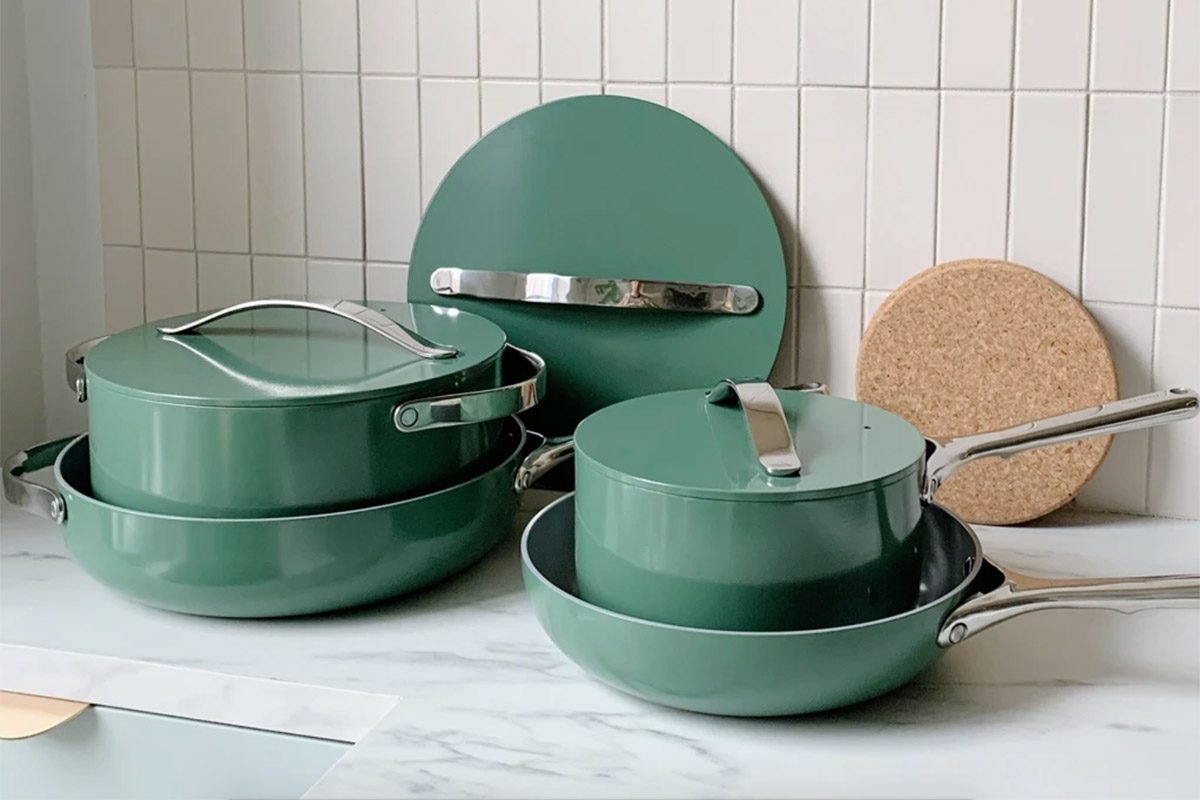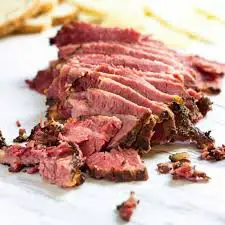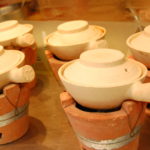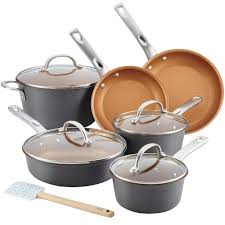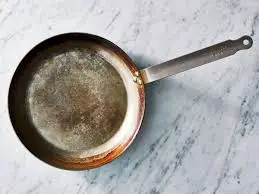Ceramic Vs Stainless Steel Cookware
Ceramic vs stainless steel cookware–which one is better? This question is highly debated in cooking forums and one finds so many threads about it. If you are interested in knowing more about it, you should go through this post thoroughly.
To begin with, healthy cooking always begins with the choice of cookware. You can choose the best, most natural ingredients, and use the safest and smartest cooking methods. However, you will still not be eating healthy food if your cookware produces toxins and other harmful substances.
When it comes to cookware, ceramic and stainless steel are two of the most popular choices. And in most homes, you’ll find both type of cookware in the kitchen. Stainless steel and ceramic are much safer than others, such as Teflon-coated nonstick cookware.
But choosing between the two isn’t always easy, because while your personal preferences may make the choice easier for you, but you should at least know what you’re getting from each.
Here’s a breakdown of the advantages and disadvantages of the two types of cookware and a comparison to help you choose.
Ceramic cookware
Ceramic cookware is one of the newest products on the nonstick cookware market. It is also a more environmentally-friendly and safer option than others such as Teflon. Although it is not as durable as stainless steel, it is still quite sturdy.
There are two types of ceramic cookware: pure ceramic, which is made from fired clay, and ceramic-coated cookware, which is sprayed with a ceramic coating over other cookware such as stainless steel and aluminum.
Recommended Product: Cook N Home NC-00358
Ceramic advantages
Toxin-free – Perhaps the biggest advantage of ceramic cookware is that it is completely toxin-free. The material is all-natural and does not release any foreign or harmful substances into the food. The natural minerals used to create the ceramic coating also do not contain common toxins such as cadmium and lead.
Non-stick – If you are looking for a safe non-stick cookware, ceramic is one of the best options. This material offers natural nonstick properties, which means you won’t have to worry about harmful coatings like Teflon. Stainless steel, on the other hand, is not non-stick.
Easy to clean – Since food doesn’t stick to ceramic, cleaning cookware is quite easy. There is no need to scrub like other cookware, and some modern models are even dishwasher safe for easy cleaning.
Even heat distribution – Ceramic heats more evenly, which means your food cooks more evenly and uniformly because there are virtually no hot or cold spots in the material.
Relatively affordable – These cookware are also relatively affordable, especially if you choose the ceramic-coated types.
Disadvantages of ceramic
Can only be used on low to medium heat – If what you plan to cook requires high heat, ceramic is not suitable as high heat can damage it. This limits its flexibility and you can only use the cookware for certain foods.
Shorter service life – Compared to stainless steel, ceramic has a relatively shorter service life because it is weaker and breaks easily. An accidental drop on the cooking surface will likely mark the end of the life of your ceramic cookware, whereas a stainless steel cookware may be subject to more abuse.
Don’t use metal utensils – It seems that many people prefer metal utensils to plastic utensils because they are more durable. However, if you use ceramic cookware, you may not be able to use them comfortably because they can easily break these delicate pans. Wood or nylon should be used to keep the coating in good condition.
Tips for using ceramic
Ceramic heats up fairly quickly, so it is important to start with a low temperature setting before mastering its use. Also, unlike stainless steel, which can withstand the highest firing temperatures, ceramic should be used on low to medium heat.
Ceramic heats up quite quickly, so it is important to start with a low temperature setting before you master its use. Also, unlike stainless steel, which can withstand the highest cooking temperatures, ceramic must be used at low or medium heat.
You must also be careful not to expose ceramic cookware to heat for extended periods of time, as it is not made for this purpose. When storing kitchen utensils, you will have to make sure to use some sort of padding between them. For one thing, they can break if they bump into each other.
Stainless steel kitchen utensils
Stainless steel kitchen utensils have been around for a long time and they don’t seem to be going out of style. With proper care, this is the type of cookware that will be passed down from one generation to the next, as it can last for many lifetimes.
This amazing cookware is made from a mixture of different metals including carbon, silicon, nickel, manganese, chromium and iron. The resulting alloy is strong, sturdy and safe.
Stainless steel is not only sturdy, but also has a beautiful shine that will always add a touch of glamour to your clean kitchen utensils. Best of all, this material won’t allow toxins or pollutants to seep into your food, making it safe for cooking.
Advantages of stainless steel
Very durable – What gives stainless steel cookware an edge over many others is that it is much more durable than most other utensils, probably only surpassed by cast iron. With stainless steel, you’ll never have to worry about common kitchen utensil problems like chipping or even rust because it’s resistant to all of those things and super durable.
Offers Great Cooking Pleasure – Stainless steel cookware is not only durable, but it is also very popular because of its incredible cooking performance. This material has fantastic heat absorption and will even get hotter than ceramic if constructed properly.
Low maintenance – There is little to do to maintain stainless steel cookware because there is no coating to worry about. You don’t need to dress up to prevent rust. Simple, regular cleaning is all that is needed to maintain this cookware, and no special techniques are required.
Non-reactive to food – Since stainless steel is a non-food reactive material, it is safe to use, even when handling acidic products. You can cook acidic recipes, such as tomato sauces, without worrying about a strange taste or leaching harmful chemicals.
Easy to clean – Like ceramic, stainless steel is very easy to clean. The smooth, non-porous surface is very easy to clean and can be soaked and cleaned quickly without sweating. In addition, most of these kitchen utensils are dishwasher safe, making them easy to clean.
Disadvantages of stainless steel
No non-stick coating – absence of non-stick coating is the biggest disadvantage of stainless steel cookware, as it means that food will stick to it while cooking. So unless you’re frying, boiling, or stir-frying, you’ll need to use plenty of oil to form a temporary non-stick surface to keep your delicate foods from sticking.
Poor heat conduction – If you are using stainless steel cookware without an aluminum or copper coating, the cooking surface is not very good because it is a poor conductor of heat. However, multi-layer types seem to solve this problem almost completely.
More expensive – If you’re on a budget, stainless steel cookware may not be for you, as it tends to be quite expensive. And while there are cheaper options on the market, they are usually inferior imitations.
Discoloration – When the exterior of cookware is exposed to high temperatures, it can easily discolor. There are many ways to maintain and restore kitchen utensils, but it will require additional work and time on your part.
Tips for using stainless steel
Although stainless steel cookware is not as easy to use as non-stick cookware, such as ceramic, you can still make great meals with it.
One simple tip to keep in mind when using these cookware is to use them like ceramic cookware.
Stainless steel cookware may not be as easy to use as non-stick ceramic models, but you can still make great meals with it.
One simple tip to keep in mind when using this cookware: always heat it up before adding the oil. Once it is hot enough, you should add a generous amount of oil and swirl it around to coat the entire bottom. Do not add food until the oil is shimmering, otherwise it may stick.
Ceramic vs stainless steel cookware
You can be sure that you will have an excellent set of cookware no matter whether you choose stainless steel or ceramic. But if you only want to buy one or the other, try to keep the following points in mind when shopping.
Which one is safer?
Both stainless steel and ceramic are safe cookware because they are made from natural materials and do not release harmful substances into the food. However, in the case of stainless steel, even a small scratch can result in the transfer of small metal particles to food.
In addition, burning stainless steel cookware can cause pitting and release small metal particles into food.
In the case of ceramics, it is usually the coloring and glaze of the cookware that contains harmful substances such as lead or cadmium. However, if the ceramic is not glazed, this is usually the safer option, but in general, both cookware is quite safe.
What one is more popular at the moment?
Stainless steel remains the most popular material in almost every household, as many people prefer it over others for its durability and ease of maintenance. However, as more and more users are looking for safer non-stick cookware, the popularity of ceramic continues to grow.
What is the most durable?
Stainless steel is by far more durable than ceramic, because if you buy genuine, high-quality stainless steel cookware, it will last a lifetime. Also, stainless steel is more durable because, unlike ceramic, accidental drops or bumps in the kitchen will not leave scratches or dents.
What is cheaper?
Quality doesn’t come cheap, so it should be obvious that stainless steel cookware is much more expensive than ceramic cookware. You can easily get a good ceramic cookware set for under $100, but for a good stainless steel cookware set you may have to spend hundreds of dollars, but it will be worth it in the end.
Wrapping up
Ceramic vs stainless steel cookware
Your choice of cookware has a significant impact on everything from safety to the quality and taste of the food you prepare, so you can’t go wrong while making your choice.
And when it comes to choosing cookware, stainless steel and ceramic are as good as it gets. However, both are made of different materials, making them suitable for different situations and types of users.
It is best to have a set of both at home. However, if you have to choose one, ceramic is the better option. If you want something more affordable and non-stick, stainless steel cookware is the best option for you provided, of course, you don’t have any budget constraints and are looking for cookware that will last you a lifetime.
